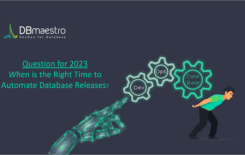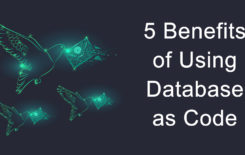Firstly, DevOps is a methodology that drives software development by making it more efficient and productive. By excluding important players like database administrators and developers, the ecosystem is less sustainable and effective. The DevOps method truly thrives when the entire organization is included in the process, from devs and IT teams, all the way to Database Admins (DBAs).
Secondly, there are security and regulatory issues to consider. Neglecting these needs often introduces risks to data and company privacy. In other words, DevSecOps is an essential part of the DevOps strategy and should not be overlooked. Companies need to enforce best database practices and policies.
Furthermore, managing business operations is becoming increasingly difficult. Without a centralized business solution that incorporates every aspect of development into the DevOps pipeline, including the database, executives often fail to achieve business continuity. Many organizations are underestimating the importance of a holistic approach to monitoring and governing database operations.
Related: Automated DevOps – The Key to Business Continuity
DevOps for Database: Main Challenges
Before touching on the solutions, let’s delve into the reasons why the adoption of DevOps strategies yet to reach the databases.
- Database Remains Siloed Outside of DevOps– Developments in the DevOps delivery pipeline have pushed DBAs into added pressure to accept code changes. This makes it easier for other stakeholders to disregard their opinions and request any changes the development team wants. However, this comes at a price of deployment loopholes and security issues.
- Competing Priorities – While developers want to make changes fast, the DBAs strive to preserve stability. Nobody is wrong, but the discrepancy between the incentives creates a conflict of interests and inevitably leads to lowering quality due to less testing, more release issues, and lack of collaboration between the teams.
- Database Professionals Are Overworked – Deployments come with a lot of responsibility from the operational and security standpoints. DBAs are often viewed as stakeholders who stop new code releases and slow down the CI/CD pipeline. But is this really their fault with so many manual processes piling up and creating massive backlogs?
To make matters worse, manual management of databases (and lack of Database DevOps) complicates the accessibility of the data, leaving no clear paths for performance improvement. As a result, DevOps cannot accelerate further and companies cannot shorten processes and improve time-to-market. Automating database delivery is no longer an option for sustainable growth.
Database DevOps: Roadblocks and Challenges
Without a continuous, automated cycle of collaboration between developers and DB teams, manual database reviews happen right before deployment. This is way too late. The later the bugs are discovered, the more expensive it is to fix them. The ideal scenario includes conducting dry-runs and testing with a Shift-Left mentality way before the production stage.
In reality, however, the pipeline lacks consistency and rarely functions properly.
Here are some roadblocks and challenges that organizations are facing today:
- Lack of Standardization – Every database engine requires a different way of managing changes. The differences occur in the way the changes are being executed and their impact on the environment. For example, SQL changes will have different consequences than Oracle or MySQL. Are you including these criteria in your planning and design?
- Architecture Diversity Issues – Having a tightly coupled architecture complicates database changes. However, newer systems include different architecture techniques like microservices that provide a simpler solution. Each microservice is assigned its own database which basically decouples the database. Are you using this methodology?
- Lack of Transparent Processes – Establishing clear and smooth processes that improve communication between developers, IT workers, and DB teams is a crucial step towards success. Reviewing database changes cannot be the afterthought at the end of the workflow cycle. It needs to become a part of the workflow with real-time insights.
The bottom line is that you need to involve DBAs as early as possible to shift database ops left and avoid bottlenecks or post-release issues. The better your cross-department collaboration is, the more transparency and clarity you will gain around your deployments. Database automation is becoming the best way to achieve Database DevOps and propel business growth.
Related: Database DevOps – A Definitive Guide
Database Delivery Automation: Top 5 Business Cases
More and more companies are releasing the business importance of database automation and treating the database as an integral part of the CI/CD pipeline. A recent IT Revolution Press survey has shown that implementing Database DevOps can help organizations deploy code 30 times faster. This is the best way to shift focus from operational chores to quality and better planning for improved performance.
Here are the top five business cases:
Avoiding Downtime and System Crashes
The shortened feedback loop updates everyone involved with alerts during the delivery process. These notifications help team members stay in-sync and catch possible bugs early on. System monitoring comes into play after the deployment. It helps you evaluate whether the system is running correctly before users or data become affected.
The Business Advantage: Continuous monitoring helps run unit tests to verify performance and discover issues before impact.
Removing Silos between Developers and DBAs
One of the issues that make Database DevOps so hard to achieve is the ongoing struggle across organizations to bring developers and DBAs together. Automating database operations is helping DBAs deploy with just a few clicks, while being able to test early and involve developers sooner for better “organizational harmony”.
The Business Advantage: Cross-department collaboration is a big pain point in the modern DevOps setup. Database automation helps solve this.
Deliver (x10-x1000) Faster
Database DevOps helps organizations deploy 46 times more frequently and recover faster after experiencing failures, while accelerating changes by 440 times. The need for speed is real when it comes to peak times and with customers expecting the best quality – fast. Automating your database will help you achieve this while improving quality without requiring additional resources.
The Business Advantage: Faster time-to-market with optimized quality means that you can achieve success without investing additional resources.
Optimizing DBA Time
Instead of being constantly swapped with changes, database administrators will become a part of the workflow. Through repeatable automated deployments, DBAs can eliminate routine tasks and avoid human errors, while focusing more on planning and quality, as well as compliance and security.
The Business Advantage: Database automation frees up time, money, and resources. There is a mindset shift from “damage control” to “business growth.”
Simplifying Compliance and Audit Processes
With a centralized automated solution, you can create a database change policy and make sure all processes are compliant with its regulations. To guarantee a smooth and clear workflow, enforce the policies on development and operation teams and keep track of the changes. Audit trails? No worries. These are also created automatically for internal and external audits.
The Business Advantage: DBAs can now implement least-privilege access, enforce policies, and manage roles and permissions with just a few clicks.
Related: Database Automation: The Final DevOps Frontier
The Time to Evolve Your Database Delivery is Now
Building a repeatable and reliable DevOps pipeline that includes your database will help you achieve continued business growth. Besides the improved quality and faster time-to-market, you will invest less in manpower and free up your resources for development-related tasks. Database DevOps is the missing link in the modern CI/CD pipeline and it needs to be addressed.
Database automation introduces a wide range of benefits that promote a Shift-Left mindset, which is the very essence of the DevOps philosophy. DBAs can test early before deploying, while enforcing strict version control for minimal deployment bottlenecks. They can also create and enforce policies that are inline with the latest organizational goals and compliance requirements.
Database DevOps implementation with a capable automation, monitoring, and governance tool can allow you to function in today’s competitive global markets. You probably have a smooth application delivery pipeline in place already, but the time to automate and Shift-Left with your database is now. This is the missing link that can allow your company to scale up fast for best results.





